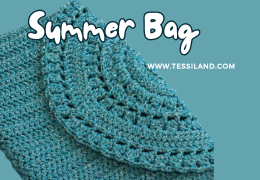Two bags, two styles, one single trend. The Japanese knot takes over summer 2025 with two irresistible crochet...
0 prodotti 0
Your cart is empty
Search in blog
Blog categories
Latest posts
-
 Two crochet bags: the Japanese knot tutorial that speaks the language of the Hadid sisters – summer 2025 editionRead more
Two crochet bags: the Japanese knot tutorial that speaks the language of the Hadid sisters – summer 2025 editionRead more -
 Crochet under the sun: summer 2025 fashion to show off with your best friend (handmade hats included!)27/07/2025Read more
Crochet under the sun: summer 2025 fashion to show off with your best friend (handmade hats included!)27/07/2025Read moreTwo crochet hats perfect for summer: a bucket hat and a mesh hat — fresh, trendy, and easy to make with our free...
-
 The coolest clutch of summer 2025 — and you can make it in 2 must-have colors. Chiedi a ChatGPT23/07/2025Read more
The coolest clutch of summer 2025 — and you can make it in 2 must-have colors. Chiedi a ChatGPT23/07/2025Read moreTwo irresistible colors, one project: the most wanted crochet clutch of summer 2025 is easy to make with the...
-
 Athens the crochet bucket bag to show off at the beach20/07/2025Read more
Athens the crochet bucket bag to show off at the beach20/07/2025Read moreLast project of our Summer Crochet series! Athens is the crochet bucket bag inspired by the colors and elegance of...
-
 Paros the trivet fish a seaside-style decoration for your beach house and beyond17/07/2025Read more
Paros the trivet fish a seaside-style decoration for your beach house and beyond17/07/2025Read moreWant to bring a touch of summer and seaside style into your kitchen? With our crochet tutorial, you can make Paros –...
Popular posts
-
 Crochet bags, the models for spring-summer.29/04/2023One of the most searched accessories on the web, patterns, tutorials, ideas, projects, accessories, here's how to...Read more
Crochet bags, the models for spring-summer.29/04/2023One of the most searched accessories on the web, patterns, tutorials, ideas, projects, accessories, here's how to...Read more -
 Crochet bags for spring summer 2024. 5 models of handmade sling bags.05/04/2024Discover the latest trends for Spring/Summer 2024 with our exclusive guide to 5 crochet sling bag models. Perfect for...Read more
Crochet bags for spring summer 2024. 5 models of handmade sling bags.05/04/2024Discover the latest trends for Spring/Summer 2024 with our exclusive guide to 5 crochet sling bag models. Perfect for...Read more -
 The Crochet Net Bucket Bag: A Trendy Accessory for 202401/06/2024Learn how to make a crochet net bucket bag with our simple and detailed tutorial. Use elastic cord, a size 5 crochet...Read more
The Crochet Net Bucket Bag: A Trendy Accessory for 202401/06/2024Learn how to make a crochet net bucket bag with our simple and detailed tutorial. Use elastic cord, a size 5 crochet...Read more -
 Crochet rugs, a passion that is becoming a trend.21/01/2024In this article, dive into the art of crochet rugs and discover how to create unique and personalized pieces for your...Read more
Crochet rugs, a passion that is becoming a trend.21/01/2024In this article, dive into the art of crochet rugs and discover how to create unique and personalized pieces for your...Read more -
 From runways to street style: the trendiest crochet bags.06/09/2023Are you also passionate about handmade items and want to create your own capsule collection of crochet bags? Here are...Read more
From runways to street style: the trendiest crochet bags.06/09/2023Are you also passionate about handmade items and want to create your own capsule collection of crochet bags? Here are...Read more
SOS: knots in yarn balls.
If you knit or crochet, you know how frustrating it can be to find a knot in the middle of your yarn ball. But why do these knots form? Are they avoidable? And most importantly, how can you handle them without compromising your work? In this article, we will answer all these questions and provide practical solutions to deal with knots in yarn with ease.
Why are there knots in yarn balls?
Yarn balls are produced by winding a long thread onto large industrial spools. When a spool runs out, it must be joined to another, inevitably creating a knot. Additionally, during production, the thread can break for various reasons:
- Mechanical stress during processing
- Material defects, especially in more delicate yarns
- Twisting and dyeing processes
- Yarn balls made with more fragile fibers, which tend to break more easily
If every defective yarn ball were discarded, the final price of the yarn would increase dramatically. For this reason, manufacturers accept a limited number of knots per ball, considering it an acceptable compromise to keep costs low and reduce waste.
How many knots are acceptable?
There is no universal rule, but industry experts agree on a limit of three knots every 50 grams of yarn. This means that in larger yarn balls, the number of knots may be proportionally higher. However, if a yarn ball has an excessive number of knots, it is advisable to contact the retailer to report the issue. At Tessiland®, we recommend writing to us immediately via email: info@tessiland.com or through our WhatsApp number.
How to deal with a knot in a yarn ball?
When you find a knot in your yarn, do not ignore it! Manufacturing knots are not always well executed and may come undone over time, causing holes in your work. The best solution is always to undo the knot and join the yarn securely. Here are some methods to do so based on the type of yarn.
1. Magic Knot
Perfect for cotton yarns and other smooth fibers, it allows you to join yarns in a strong and invisible way. Simply overlap the two ends, knot them together, and tighten the knots until they slide against each other. Finally, trim the excess.
2. Russian Join
Ideal for wool and acrylic, this method requires a sharp needle. Each end is threaded through the needle and passed inside its own yarn for about 5-7 cm. This creates a strong joint without visible knots.
3. Knitted Join
Perfect for yarns made of multiple strands, such as twisted ones. It involves splitting the strands and gradually overlapping them, working a few stitches with both ends for a natural fusion.
4. Magic Knot "No Ends"
This advanced method is excellent for acrylic. Wrap the yarn around your thumb, pass it between the ends, and pull until a strong knot forms without cutting anything.
5. Felting Join
If the yarn is 100% untreated wool, you can join the ends by rubbing them with warm water and soap. This process will make them adhere to each other without the need for knots or sewing.
What if the yarn ball has too many knots?
If you find more than three knots in a single yarn ball (or even multiple knots close together), take a photo and contact your retailer's customer service. A good supplier will offer you a solution, which may range from replacing the yarn ball to a partial refund.
Knots in yarn balls are inevitable, but they should not ruin your knitting or crochet experience. With the right joining methods, you can handle them with ease and ensure the longevity of your project. The next time you find a knot in your yarn, instead of getting discouraged, try one of the methods we suggested—your work will thank you!
Rosaria Tessiland®
.jpg)



